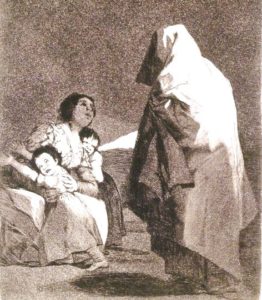By Lisa Smith (Regular Contributor)
One of the more elusive bogeymen is Rawhead and Bloody Bones. The Oxford English Dictionary notes references to this monster dating from the mid-sixteenth century and the tale was widespread enough to be imported to the United States, but actual early stories about Rawhead and Bloody Bones are scant on the ground. Rather, his name is more likely to be used as a warning: ‘Keep away from the marl-pit or Rawhead and bloody bones will have you!’ Although he was associated with pools of water, he might also be found living in cupboards or under stairs, sat upon the bones of naughty children. But the whys and wherefores of his determination to punish children is unclear.
Rawhead was also a creature lurking in the nursery—a terrifying assistant to the busy mother or nursemaid for keeping children under control. As John Locke put it in Some Thoughts Concerning Education (1693):
This he will be in danger of from the Indiscretion of Servants, whose usual Method is to awe Children, and keep them in subjection, by telling them of Raw-head and Bloody-bones, and such other Names as carry with them the Ideas of something terrible and hurtful, which they have Reason to be afraid of when alone, especially in the Dark. This must be carefully prevented: For though by this foolish way, they may keep them from little Faults, yet the Remedy is much worse than the Disease.
(Dolly Parton has a charming account of her own mother’s invocation of Rawhead and Bloody Bones when trying to put twelve children to bed, which is well worth a listen.)
By the late seventeenth century, people were beginning to question the wisdom of relying on stories about bogeymen. The real problem, of course, wasn’t scaring small children – but its long-term damage, particularly when it came to training the men of the future. Locke noted that the minds of the young were impressionable and such fancies ‘frequently haunt them with strange Visions, making Children Dastards when alone, and afraid of their Shadows and Darkness all their Lives after’ (138).
He provided a cautionary true tale, beginning (oddly enough) in a fairy-tale fashion: ‘There was in a Town in the West a Man of a disturbed Brain, whom the Boys used to teaze when he came in their way’. One day, the man seized a sword from a nearby cutler’s shop and chased a boy. The boy escaped—just—to his house, and as he was about to turn the latch, he chanced to look behind ‘to see how near his Pursuer was, who was at the Entrance of the Porch, with his Sword up ready to strike; and he had just Time to get in, and clap to the Door to avoid the Blow, which, though his Body escaped, his Mind did not’ (139). The boy was haunted into adulthood by the memory, always having to check behind him when going in that door.
Dialogues on the passions, habits, and affections peculiar to children by James Forrester (1748) was much more specific about the damage, which Forrester blamed on nurses, mothers and grandmothers. Forrester mused that ‘something of Raw-head and Bloody-bones occurs to you as often as you look into a dark unfrequented Corner of a Church’, which came from ‘some Remains of the Nursery, some Remnants of Fear, and that Idea of Dread, which, Thanks to our Mothers and Grandmothers, is constantly connected with Churches, Church-years, and Charnel-houses’ (27).
The first stage of fear, connected to self-preservation, began before the age of five. Carers could use:
the Appearance of Objects, capable of giving them Pain; Objects, with the Idea of Pain, connected with them by the Imagination, such as Raw-head and Bloody-bones, &c. &c. Objects, that are new to them, with the Idea of Danger connected to them, and sudden Surprizes, which in Young and Old always create some Degree of Terror, but in Children more especially (33).
The second stage of fear was nurtured by the stories of women who ‘have strong Faith in Spirits, Apparitions, and Witches, love to hear and repeat Stories of that Kind’ (35). In this way, the children’s imaginations were trained to connect mischievous spirits with horror and dark places. The third stage of fear was connected to punishment. As the nursemaid switched from relying on the threats of bogeymen to using actual corporal punishment to ensure good behaviour, the child blurred the boundaries between the types of punishment in his own mind. And this was most dangerous of all, according to Forrester:
If the Spirit is kept long in this Subjection, Timidity becomes a Habit, and nothing afterwards can persuade it to look at the most visible Terror, and all he Marks of Cowardice, which is the lowest and must abject State, to which a rational Creature can be reduced (37).
The whys and wherefores of Rawhead and Bloody Bones’ punishment apparently didn’t need explanation, since the real terror of the nursery–for the Enlightened male–was the long-term effects masculine rationality, perpetuated by the wild imaginations of women and servants.
I leave you with ‘Rawhead and Bloodybones’ by Siouxsie and the Banshees, mashed up with a video clip from Jan Svankmajer’s “Neco z Alenky” (Alice)–which together evokes the terrors of the nursery and the suspension of rationality.
Lisa Smith is a historian of gender and medicine in eighteenth-century France and England, and has published widely on leaky bodies, pain, fertility, and the household. She is finishing a book on “Domestic Medicine: Gender, Health and the Household in Eighteenth Century England and France”. In addition to developing an online database of the Sir Hans Sloane Correspondence, she is a co-investigator on a crowd-sourcing recipes transcription project. She blogs at The Sloane Letters Blog, co-edits The Recipes Project and tweets as @historybeagle.

